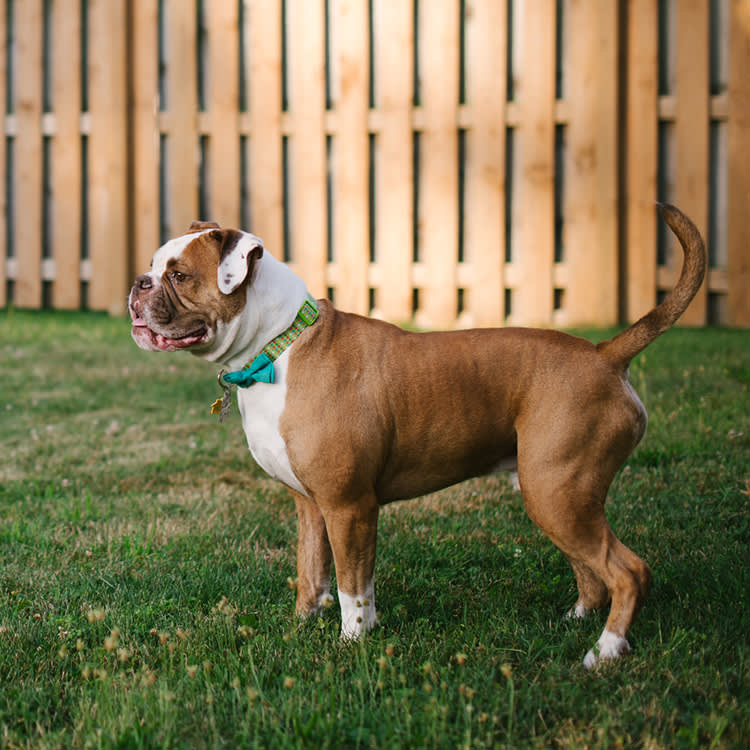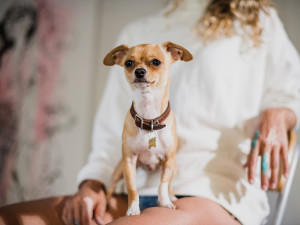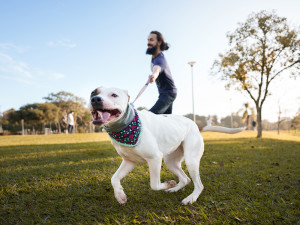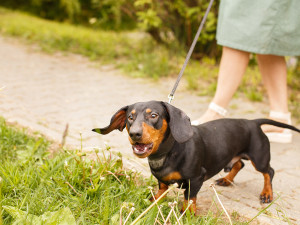“How Do I Get My Dog to Stop Jumping at the Fence?”
Dog trainer Robert Haussmann’s tips for calming down a dog who’s protective of their turf.
Jack is a super good boy. The only problem is Jack and his sister Callie are fence fighters. They bark at everyone who goes by, including children, moms with strollers…god forbid they have a dog with them. Jack appears especially scary, throwing himself against the fence. Being part Pittie, he can’t afford any trouble. How do I get Jack to stop being overly protective of his turf and lunging at the fence? — Adria
Jack sounds amazing, and it’s great that he’s found such an understanding family. It sounds like Jack is very protective; he’s probably anxious when outsiders approach, because he sees them as potential intruders. It’s a loving instinct, but as you’ve seen, it can come across as “scary” — and you’re right that, unfortunately, aggressive behavior is judged especially harshly in Pit Bulls.
Trick question: All dogs are perfect! But find out which type is the best fit for you.
It can take a long time to train a dog to be less protective, because what you’re really trying to do is calm them, which means changing their emotional reactions. It’ll take a lot of patience and there’s no one-size-fits-all solution, but don’t lose hope — there are ways to relax a fence-attacking dog.
First of all, you need to keep Jack out of the yard until the problem is resolved. Every time he practices leaping at the fence, he gets better at doing it. Right now, Jack potentially sees people as a threat, which is why he’s lunging and barking. He may be trying to discourage the people passing by from entering your property. What’s tricky is that when he barks and lunges and then people continue walking by, he may be seeing this as a cause-and-effect situation; this means every time he barks and someone doesn’t enter, it reinforces his belief that he must bark, because he’s doing a good job protecting his yard.
How much do you spend on your pet per year?
If there’s any way to block the area from him, he’ll have less of a chance to reinforce the habit. I don’t know Jack well enough to give you exact parameters, but you should find other ways for him to get out and urinate without guarding the fence. If that means you can build a separate section away from that side of the yard, that’s great. If it means he may have to do his business on a leash or on walks for now, that’s another option. But if he’s out in the yard tomorrow doing this, he’s only getting better at it.
How to Get Your Dog to Relax
Next, you should engage in a relaxation protocol. I recommend the Karen Overall Relaxation Protocol. opens in new tab What this does is teach your dog to stay still while more intense things are happening around them. That can start in the house with both dogs; you may have to start one at a time, depending on where they each are in their training. If you can get them to stay while taking, let’s say, three steps back, that might be your day one training.
The next day, you have them stay while you clap your hands, then while you turn your back, then while you go to another room — basically, you’re building up to more and more exciting, distracting things happening in their environment. Eventually, you want them to be able to stay still while you open the front door, ring the doorbell, or sit on the ground.
You would then take those skills out into the yard with them on their leashes, probably one dog at a time, and train them to sit and stay calm while people are passing. It’s important that you reward them for staying calm when people pass. We need to change your dog’s emotional association to people passing by. That means giving lots of treats and pets — or whatever their favorite thing is — whenever they exhibit good behavior.
Again, this could be a long road. Avoid using things that promise to be quick fixes. Using force or something that creates pain, like an invisible fence or shock collar, can give you a short term change, but the emotional association toward the trigger is likely going to get worse. Jack will just become more concerned about — and afraid of — people passing by, because he’ll associate them with punishment. Instead, use high-value reinforcement for staying calm in the presence of the trigger. This process will take time and patience, but it’s absolutely possible to change Jack’s relationship with the backyard fence.








